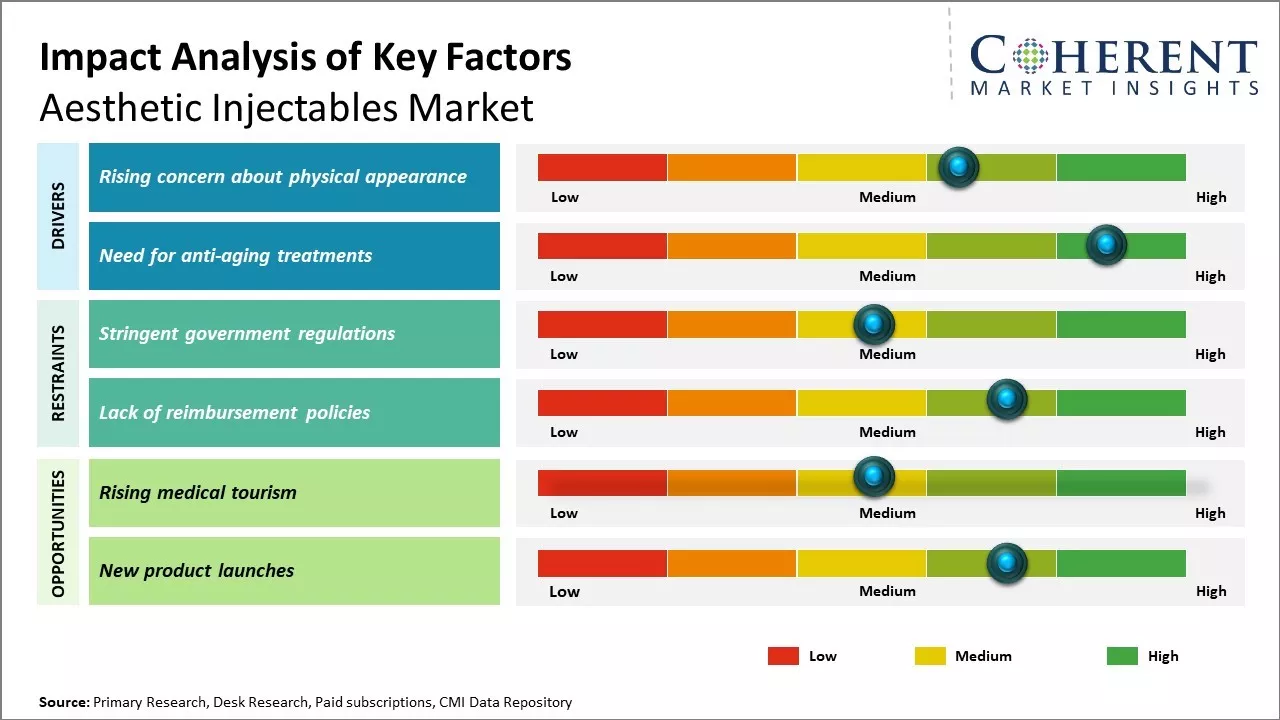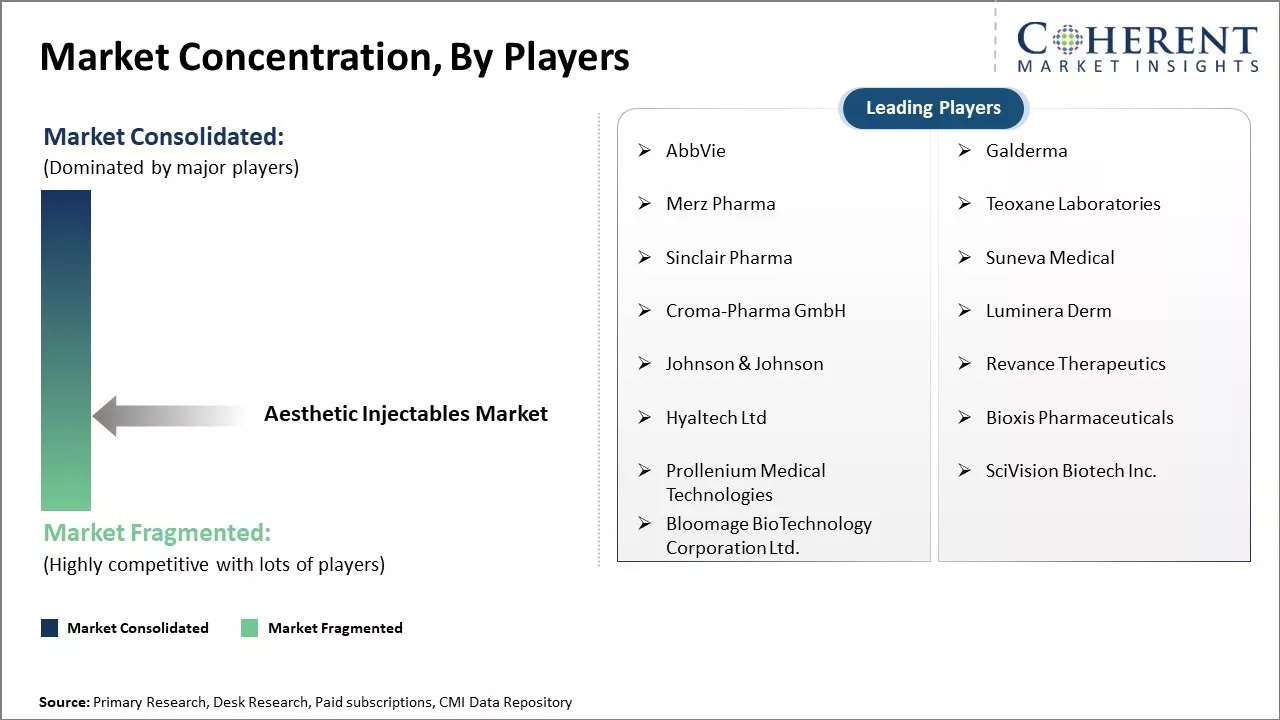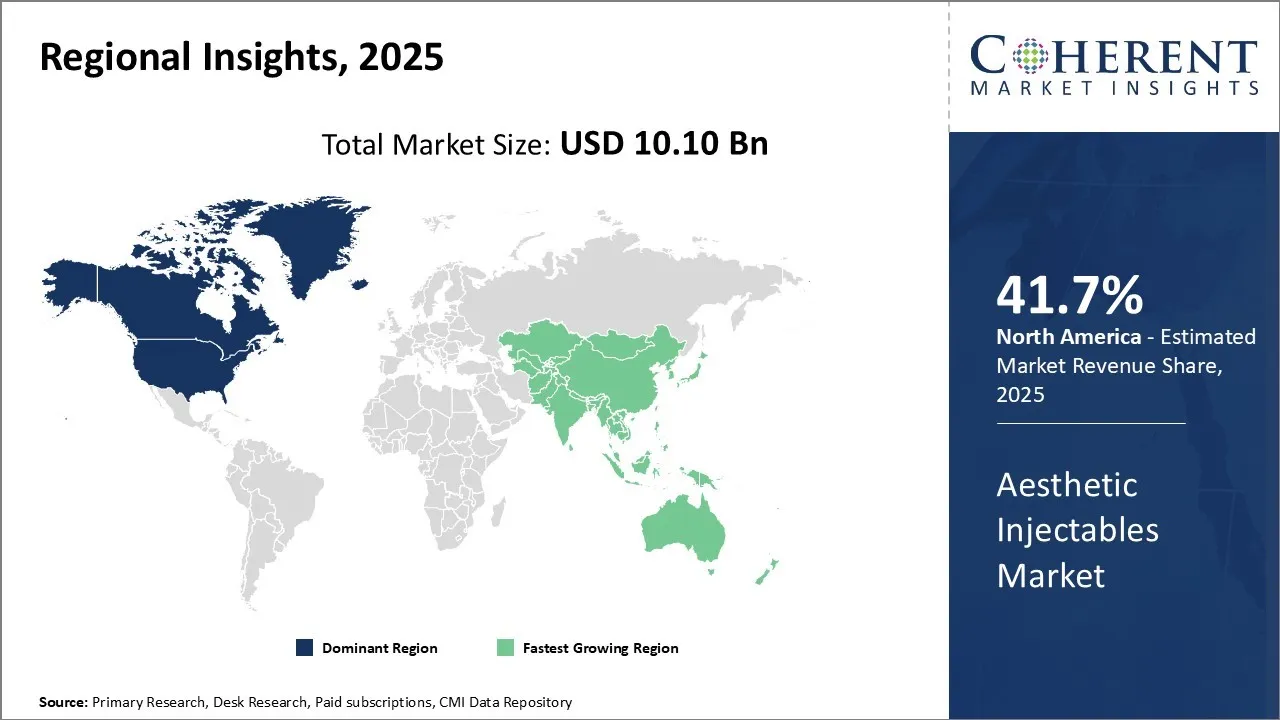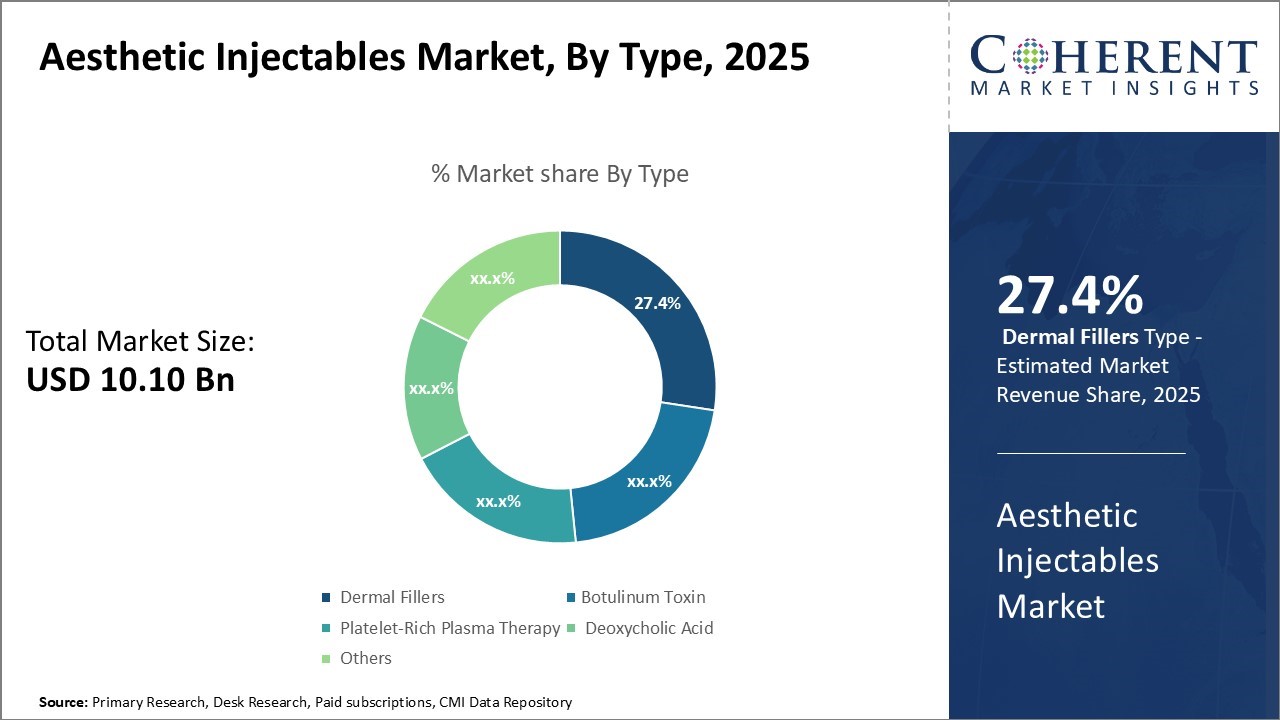Aesthetic Injectables Market Size and Trends Forecast – 2025 - 2032
The aesthetic injectables market is estimated to be valued at USD 10.10 Bn in 2025 and is expected to reach USD 22.48 Bn by 2032, exhibiting a compound annual growth rate (CAGR) of 12.1% from 2025 to 2032.

To learn more about this report, Download Free Sample
Key Takeaways of the Aesthetic Injectables Market
- By type, the dermal fillers segment is estimated to contribute a 27.4% share of the market in 2025.
- By application, the acne scar treatment segment is estimated to contribute the highest market share of 30. 3% in 2025.
- By end user, the dermatology clinics segment is estimated to contribute the highest market share of 57.6% in 2025.
- North America remains the dominant player in the aesthetic injectables market and is estimated to account for 41.7%of the global market share in 2025.
Market Overview
The aesthetic injectables market is witnessing positive trends with the rising number of aesthetic procedures. With increasing aesthetic consciousness and access to newer products and services, more people are opting for minimally invasive aesthetic treatments. Procedures, such as botox and dermal fillers, are becoming increasingly popular globally to treat signs of aging, facial wrinkles, and folds. The availability of new product variations and formulations that cater to diverse consumer needs along with the increasing social acceptance of aesthetic treatments have been driving the market growth over the past few years.
However, the high cost of certain premium products remains a challenge along with medical and post procedure complications for some people.
Market Concentration and Competitive Landscape

To learn more about this report, Download Free Sample
Current Events and Its Impact
|
Current Events |
Description and its impact |
|
Geopolitical Trade Policies and Tariffs |
|
|
Economic and Consumer Behavior Trends |
|
Uncover macros and micros vetted on 75+ parameters: Get instant access to report
Need for Anti-aging Treatments
Aging is an inevitable process that starts showing its effects from 30s on the facial skin and structure. Factors like sun exposure, pollution, and stress gradually take a toll leading to the formation of wrinkles, loss of volume, and definition. While this was considered a natural part of life earlier, people today want ways to slow down or reverse the visible signs of aging. The desire to look and feel younger has increased manifold.
For instance, NAD+ Rejuvenation Therapy plays a crucial role in energy production and DNA repair. This coenzyme drives many cellular processes, making it essential for overall health and longevity. NAD+ stands for nicotinamide adenine dinucleotide. It plays a crucial role in cellular metabolism. This co-substrate supports enzymes that modify the ageing process. High levels of NAD+ can slow or reverse aspects of ageing and delay age-related diseases.
Stringent Government Regulations
The aesthetic injectables market faces several challenges. Procedures often require frequent repeat visits, making long-term customer retention difficult. Many patients struggle with perceived risks from unlicensed or under-qualified practitioners. Strict regulations vary widely globally, necessitating navigating an intricate regulatory landscape. Additionally, market saturation in key territories pressures providers to continually develop new solutions and reach newer demographics.
Aesthetic Injectables Market Insights, by Type: Growing Demand for Non-surgical Cosmetic Procedures is Augmenting the Dermal Fillers Segment Growth
The type segment includes botulinum toxin, dermal fillers, platelet-rich plasma (PRP) therapy, deoxycholic acid, and others. The dermal fillers segment is estimated to hold 27.4% share of the market in 2025. Dermal fillers are injections used to repair skin depressions and wrinkles without surgery.
Dermal fillers allow smoothing of fine lines and wrinkles with minimal time commitment and downtime compared to surgical procedures like facelifts or laser treatments. The non-surgical nature and immediate results have made dermal fillers extremely popular among both younger consumers looking to prevent signs of aging and older individuals seeking to reverse the effects of aging. Moreover, the availability of a wide range of dermal filler products at varying prices has ensured options for all budgets.
Aesthetic Injectables Market Insights, by Application: Rising Prevalence of Acne and Scarring
The application segment includes lip enhancement, wrinkle reduction, acne scar treatment, cheekbone augmentation, and others. The acne scar treatment sub segment is expected to have 30.3% of the market share in 2025. Acne is one of the most common skin conditions affecting people of all ages. While acne can be temporarily treated with topicals and oral medications, its scarring often requires dedicated procedures.
Acne scarring including boxcar, rolling, and ice pick scars can have significant psychological impact by making skin appearance uneven. As people are recognizing the importance of clear skin in building self-confidence, the demand for acne scar treatments has surged. Aesthetic injectables help treat acne scars through collagen stimulation and skin contouring. Combination therapies using dermal fillers along with lasers or fractional radiofrequency effectively reduce acne scarring appearance.
Aesthetic injectables Market Insights, by End User: Convenience and Personalized Expertise is Propelling the Demand for Dermatology Clinics
The end user segment includes hospitals, dermatology clinics, and others. The dermatology clinics segment accounts for the highest share of the market and is anticipated to hold 57.6% of the market share in 2025. Their comprehensive evaluation of medical history and customized treatment plans inspire higher confidence among cosmetic procedure seekers.
Dermatology clinics also have advanced medical infrastructure, equipment, and trained staff to safely and effectively administer aesthetic injectables. Board certifications and focused experience treating a wide spectrum of skin conditions give dermatologists a thorough understanding of anatomy and potential side effects. Their experience administering numbing agents and technique greatly reduces pain and yields consistent, natural looking results.
Emerging Innovations in the Aesthetic injectables Market
- Advanced Laser Treatments
- Application: Lasers have long been a staple in medical aesthetics, but recent innovations have led to even more precise and effective treatments. From fractional laser resurfacing for fine lines and wrinkles to laser hair removal for all skin types, cutting-edge technologies are offering faster results and shorter recovery times.
- Body Sculpting Techniques and Contouring
- Application: The desire for well-defined bodies has led to the rise of advanced body sculpting and contouring techniques. Non-invasive procedures like CoolSculpting and EMSCULPT use controlled cooling and electromagnetic energy to target stubborn fat and tone muscles, providing a more sculpted physique without surgery.
Impact of AI on the Aesthetic Injectables Market
Artificial intelligence continues to revolutionize the aesthetic injectables sector by enhancing design innovation.
- FaceReveal’s incorporation of artificial intelligence (AI) to simulate minimally invasive treatments and quantify first impressions has not only transformed the way practitioners approach aesthetics but also left a significant mark on aesthetic pharmaceutical companies.
- AI algorithms also facilitate personalized treatment plans by analyzing vast datasets of patient anatomy, treatment history, and outcomes, allowing clinicians to tailor procedures to individual needs and skin types. This level of customization drives higher success rates and repeat business.
Regional Insights

To learn more about this report, Download Free Sample
North America Aesthetic Injectables Market Analysis and Trends
The North America region is anticipated to hold 41.7% of the market share in 2025. The region is dominating, owing to factors like increasing consumer awareness about aesthetic procedures and a strong foothold of key market players in the region.
According to a study by the American Society of Plastic Surgeons, published in January 2025, there is a 5 % increase in overall cosmetic surgery procedures between 2022 and 2023. There is no reason to believe that interest and demand for these procedures decreased in 2025, with innovations, new techniques and new products hitting the market and your plastic surgeon's office.
Asia Pacific Aesthetic Injectables Market Analysis and Trends
Asia Pacific has emerged as the fastest growing regional market for aesthetic injectables in recent times. The growth can be attributed to rapidly changing lifestyles and increasing spending power on personal care in developing countries like China, India, and South Korea. These nations have stepped up investments in medical tourism to capitalize on the burgeoning demand from domestic as well as international patients.
Switzerland Global Enterprise announced that Cosmoprof Asia, Asia’s premier B2B beauty trade fair, will take place at the Hong Kong Convention & Exhibition Centre (HKCEC) from November 12-November 14, 2025. The event will concentrate on finished, branded products spanning all primary cosmetic categories, including Perfumery & Cosmetics, Beauty Salon & Spa, Nail & Accessories, Hair Salon, and Natural & Organic.
U.S. Aesthetic Injectables Market Analysis and Trends
In the U.S., the aesthetic injectables market is driven by a combination of high disposable income, broad consumer acceptance, and a well-established network of certified practitioners. The market benefits from a culture that prioritizes self-care and cosmetic enhancement, with millennials and Gen Z embracing early, preventative treatments.
JUVÉDERM is the #1 chosen dermal filler collection in the U.S. with six unique fillers designed for 10 specific areas of the face. Approved Uses OF JUVÉDERM VOLUMA XC injectable gel is for deep injection in the cheek area to correct age-related volume loss, for augmentation of the chin region to improve the chin profile, and for augmentation of the temple region to improve moderate to severe temple hollowing in adults over 21.
South Korea Aesthetic Injectables Market Analysis and Trends
South Korea is a global leader in aesthetic innovation and procedure volume, often referred to as the “plastic surgery capital of the world.” The aesthetic injectables market here is driven by deep-rooted beauty standards, a tech-savvy population, and a thriving medical tourism industry. The government’s support for cosmetic medical exports and high domestic demand for minimally invasive procedures have led to rapid advancements in formulation techniques, particularly in HA fillers and botulinum toxins produced by local players like Medytox and Hugel.
India Aesthetic Injectables Market Analysis and Trends
India’s aesthetic injectables market is expanding swiftly, propelled by urbanization, rising disposable incomes, and an emerging youth segment highly influenced by social media trends and celebrity culture. While still considered a developing market, affordability improvements, growing availability of trained aesthetic professionals, and increased awareness through digital platforms are helping normalize cosmetic procedures. Preventative injectables are gaining traction among younger demographics, making India a high-potential, fast-growth region in the global aesthetic landscape.
Brazil Aesthetic Injectables Market Analysis and Trends
In Brazil, a strong emphasis on physical appearance and body image significantly fuels demand for aesthetic treatments. The aesthetic injectables market is growing rapidly, supported by a large population base, increasing affordability of treatments, and the influence of beauty culture in media and social networks.
Moreover, regulatory modernization by ANVISA (Brazil’s health authority) and the expansion of aesthetic clinics into Tier 2 and Tier 3 cities have broadened access to procedures across socio-economic segments.
Pricing Analysis
- Small to Mid-sized Aesthetic Clinics and Individual Practitioners
- Treatment prices typically range from USD 300 to USD 600 per syringe or vial, depending on the product type (e.g., hyaluronic acid fillers, botulinum toxin), brand, and formulation (standard vs. longer-lasting).
- Smaller clinics often purchase in low volumes, leading to higher per-unit costs due to limited bulk discounts, added storage, and handling expenses.
- Pricing for patients can vary widely based on procedure complexity and geographic location, with urban areas like New York, Los Angeles, and London commanding premium pricing due to higher overhead and demand.
- Large Multi-clinic Chains and Medical Spas
- For bulk orders (≥100 syringes/vials), prices can drop to USD 250–450 per unit, benefiting from volume discounts (10–30%) negotiated directly with manufacturers or distributors.
- These buyers often standardize products across locations, simplifying inventory and reducing logistics costs.
- Key suppliers such as Allergan, Revance, and Ipsen provide tailored pricing and support programs, including training and marketing assistance, factored into overall contract pricing.
- Direct-to-Consumer (DTC) and Telemedicine Platforms
- Online aesthetic platforms offering virtual consultations combined with home-delivery injectables price treatments between USD 350 to USD 700, depending on formulation strength, brand, and convenience services.
- Personalized treatment packages or combination therapies command a 20–40% premium over single-product procedures.
- Additional fees for teleconsultations, expedited shipping, and follow-up care are common and can add USD 50–150 per treatment cycle.
Market Report Scope
Aesthetic Injectables Market Report Coverage
| Report Coverage | Details | ||
|---|---|---|---|
| Base Year: | 2024 | Market Size in 2025: | USD 10.10 Bn |
| Historical Data for: | 2020 To 2024 | Forecast Period: | 2025 To 2032 |
| Forecast Period 2025 to 2032 CAGR: | 12.1% | 2032 Value Projection: | USD 22.48 Bn |
| Geographies covered: |
|
||
| Segments covered: |
|
||
| Companies covered: |
AbbVie, Galderma, Merz Pharma, Teoxane Laboratories, Sinclair Pharma, Suneva Medical, Croma-Pharma GmbH, Luminera Derm, Johnson & Johnson, Revance Therapeutics, Hyaltech Ltd, Bioxis Pharmaceuticals, Prollenium Medical Technologies, SciVision Biotech Inc., and Bloomage BioTechnology Corporation Ltd. |
||
| Growth Drivers: |
|
||
| Restraints & Challenges: |
|
||
Uncover macros and micros vetted on 75+ parameters: Get instant access to report
Aesthetic Injectables Industry News
- In January 2025, Allergan Aesthetics, an AbbVie company, the industry leader in aesthetics globally, innovated and elevated the patient journey with the launch of its new AA Signature Program at the International Master Course on Aging Science (IMCAS) World Congress 2024 in Paris. Congress highlights to include the Allergan Medical Institute (AMI) symposium, with a live injection session, Meet the Expert presentations, and an interactive exhibition booth.
- In January 2025, Galderma demonstrated injectable aesthetics leadership in medication-driven weight loss with new research and first international consensus-based guidelines.
- In March 2025, Merz Aesthetics, the world’s largest dedicated medical aesthetics business, unveiled a new data on its product portfolio and offer insights into the latest trends in the industry at the 2025 Aesthetic and Anti-Aging Medicine World Congress held in Monaco.
- In March 2025, SciVision participated in AMWC Monaco 2025, held from March 27–29 at the Grimaldi Forum, Monaco, where the company showcased its latest hyaluronic acid fillers and injectable solutions, highlighting its commitment to innovation and excellence in aesthetic medicine.
Analyst View
- A significant driver of market growth is the rising adoption of aesthetic injectables among younger consumers, particularly those under 35. This group now represents 40% of all procedures, reflecting a shift toward preventative treatments aimed at maintaining youthful appearance rather than reversing aging. This early engagement is driving repeat demand and long-term market expansion, as younger patients begin treatments earlier and return more frequently.
- Technology is accelerating the evolution of the aesthetic injectables market. AI-assisted procedures are improving treatment precision, consistency, and patient outcomes, making clinics more efficient and results more predictable. Additionally, the rise of combination therapies—where injectables are paired with energy-based or topical treatments—is increasing average transaction values and deepening patient commitment to aesthetic regimens. Together, these innovations are pushing the market toward higher-value, tech-enabled growth.
- In North America, the aesthetic injectables market is showing signs of maturation, with high procedure penetration and established consumer awareness. Growth here is driven more by product innovation, brand loyalty, and repeat treatments than by new patient acquisition.
- In contrast, the Asia Pacific region is emerging as the fastest-growing market, fueled by a rising middle class, increasing beauty consciousness, and growing access to aesthetic services. Analysts see APAC as the key engine of future volume growth, particularly in urban centers across China, South Korea, and Southeast Asia.
Market Segmentation
- Type Insights (Revenue, USD Billion, 2020 - 2032)
- Botulinum Toxin
- Dermal Fillers
- Platelet-Rich Plasma (PRP) Therapy
- Deoxycholic Acid
- Others
- Application Insights (Revenue, USD Billion, 2020 - 2032)
- Lip Enhancement
- Wrinkle Reduction
- Acne Scar Treatment
- Cheekbone Augmentation
- Others
- End User Insights (Revenue, USD Billion, 2020 - 2032)
- Hospitals
- Dermatology Clinics
- Others
- Regional Insights (Revenue, USD Billion, 2020 - 2032)
- North America
- U.S.
- Canada
- Latin America
- Brazil
- Argentina
- Mexico
- Rest of Latin America
- Europe
- Germany
- U.K.
- Spain
- France
- Italy
- Russia
- Rest of Europe
- Asia Pacific
- China
- India
- Japan
- Australia
- South Korea
- ASEAN
- Rest of Asia Pacific
- Middle East
- GCC Countries
- Israel
- Rest of Middle East
- Africa
- South Africa
- North Africa
- Central Africa
- Key Players Insights
- AbbVie
- Galderma
- Merz Pharma
- Teoxane Laboratories
- Sinclair Pharma
- Suneva Medical
- Croma-Pharma GmbH
- Luminera Derm
- Johnson & Johnson
- Revance Therapeutics
- Hyaltech Ltd
- Bioxis Pharmaceuticals
- Prollenium Medical Technologies
- SciVision Biotech Inc.
- Bloomage BioTechnology Corporation Ltd.
Sources
Primary Research Interviews
- Aesthetic Injectable Manufacturers (e.g., Allergan Aesthetics (AbbVie), Revance Therapeutics, Ipsen, Hugel, Medytox)
- Dermatologists and Aesthetic Practitioners (medical spas, clinics, cosmetic dermatology centers)
- Plastic and Reconstructive Surgeons
- Cosmetic Procedure Clinic Owners and Medical Directors
- Procurement Heads and Distributors in the Medical Aesthetics Industry
Magazines
- Aesthetic Medicine Magazine
- Dermascope
- Modern Aesthetics
- Practical Dermatology
- Cosmetic Surgery Times
- MedEsthetics Magazine
- Others (e.g., Prime Journal, The Aesthetic Guide)
Journals
- Aesthetic Surgery Journal (ASJ)
- Journal of Cosmetic Dermatology
- Plastic and Reconstructive Surgery Journal
- Dermatologic Surgery
- Clinical, Cosmetic and Investigational Dermatology
- Others
Newspapers
- The Wall Street Journal
- Financial Times
- The Economic Times
- Business Standard
- Forbes (Healthcare & Beauty section)
- Others
Associations
- International Society of Aesthetic Plastic Surgery (ISAPS)
- American Society for Aesthetic Plastic Surgery (ASAPS)
- American Academy of Dermatology (AAD)
- International Association for Physicians in Aesthetic Medicine (IAPAM)
- British College of Aesthetic Medicine (BCAM)
- Others
Public Domain Sources
- U.S. Food and Drug Administration (FDA) – product approvals and safety data
- European Medicines Agency (EMA)
- Centers for Medicare & Medicaid Services (CMS) – U.S. healthcare spending trends
- Eurostat – Health and Wellness Industry Statistics
- World Bank Open Data
- UN Comtrade Database – Medical and Cosmetic Preparations
- Others
Proprietary Elements
- CMI Data Analytics Tool – Aesthetic injectables Market
- CMI Existing Repository of Information for the Last 8 Years
*Definition: The aesthetic injectables market involves pharmaceutical products used for aesthetic purposes to enhance personal appearance. It includes dermal fillers, botulinum toxin, and collagen stimulators that are injected into the skin temporarily reshaping features or minimizing the appearance of wrinkles and facial lines. These injectable cosmetic procedures are increasingly popular among people looking to address signs of aging or enhance certain facial features in a minimally invasive manner. The global aesthetic injectables market has seen significant growth in recent years.
Share
Share
About Author
Vipul Patil is a dynamic management consultant with 6 years of dedicated experience in the pharmaceutical industry. Known for his analytical acumen and strategic insight, Vipul has successfully partnered with pharmaceutical companies to enhance operational efficiency, cross broader expansion, and navigate the complexities of distribution in markets with high revenue potential.
Missing comfort of reading report in your local language? Find your preferred language :
Transform your Strategy with Exclusive Trending Reports :
Frequently Asked Questions
EXISTING CLIENTELE
Joining thousands of companies around the world committed to making the Excellent Business Solutions.
View All Our Clients

